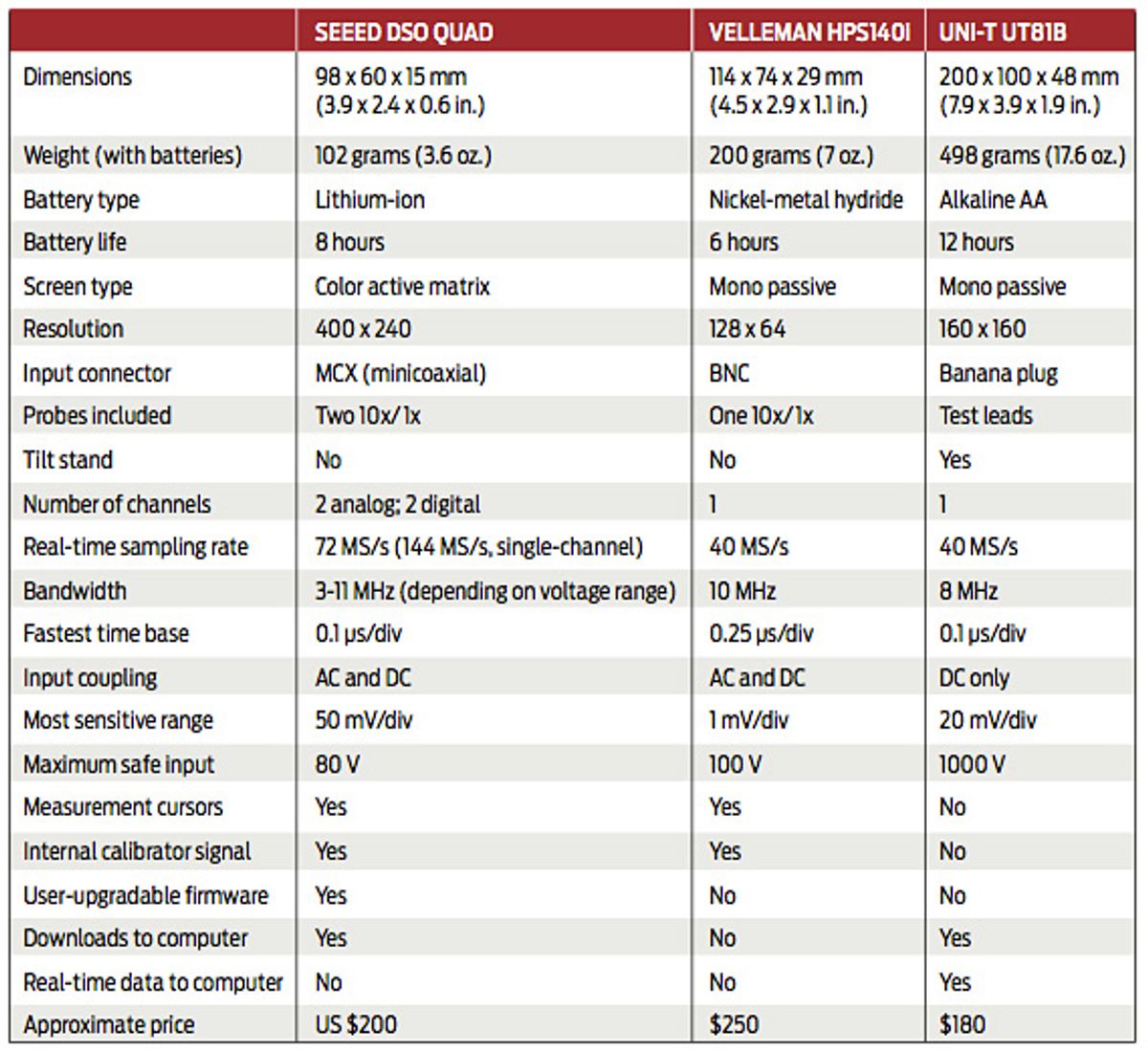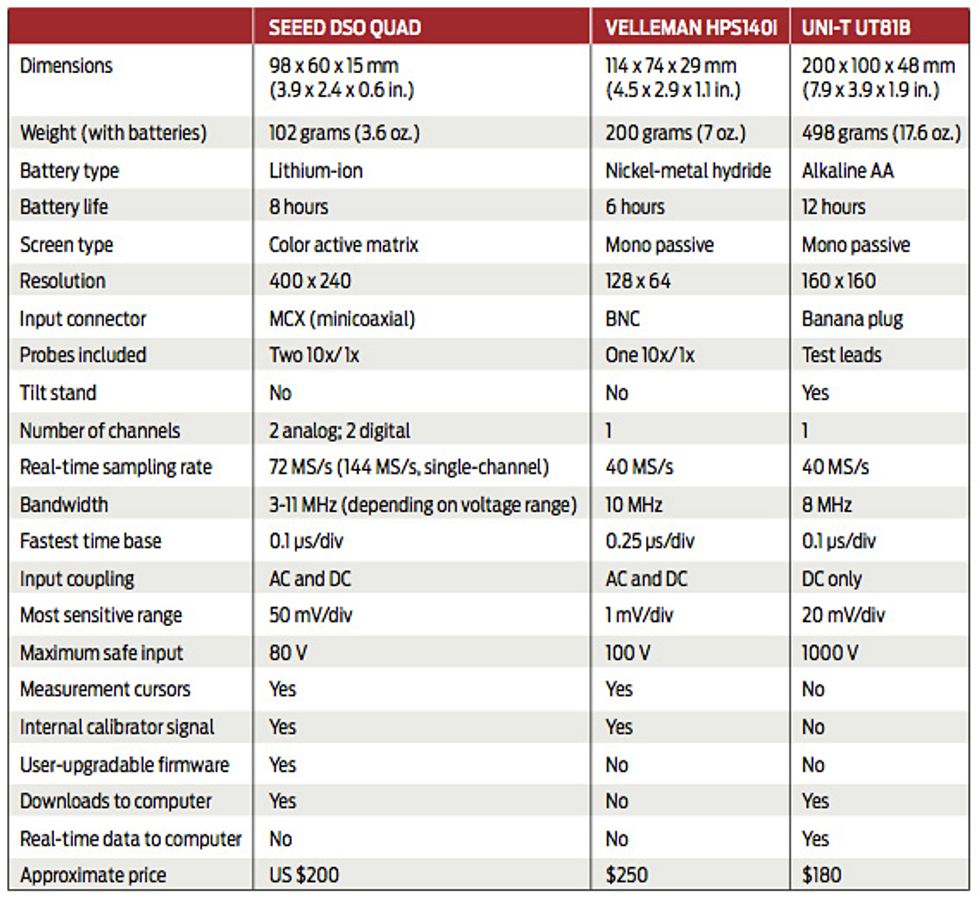Ever knelt behind a home-theater receiver, tangled in wires, trying to figure out why nothing’s coming out of the stereo speakers? Is the cable bad? Is the cable box even putting out the digital audio signal? Oh, if only you could whip out a scope from your pocket and check. As it turns out, you can. Here’s a look at three pint-size oscilloscopes.
Perhaps the most ambitious pocket scope yet attempted, the DSO Quad (left), from Seeed Studio, is smaller than a smartphone. It offers four input channels (two analog, two digital), a gorgeous, high-contrast, active-matrix color screen, and measurements galore. Peak-to-peak voltage, duty cycle, frequency—you name it and this scope will measure it. That is, once you calibrate the thing! The Quad comes completely uncalibrated, requiring you to adjust tiny trimmer capacitors and perform a multistep firmware voltage calibration as well.
All this power is wrapped up in one of the most convoluted user interfaces I’ve ever seen. Eventually, you’ll get the hang of its four push buttons and two multipurpose swivel controls, which move back and forth and also up and down. The interface will surely improve, because the Quad is an open-source project. Such goodies as audio frequency response plotting and fast Fourier transform analysis, as well as bug fixes, have been released or are in development.
Remarkable as it is, the Quad is still more of a hobbyist’s gadget than a serious instrument. Despite its admirably fast sampling rate, the op-amp–based analog front end exhibits quirky, inconsistent response, which limits the bandwidth and accuracy. Some of the displayed measurements are wildly wrong. The Quad is great for casual waveform viewing, though, especially if you need to see multiple signals. It even includes a crude but useful function generator that outputs sine, square, triangle, and sawtooth waves.
The Quad comes with two analog probes and a USB cable for charging its internal lithium-ion battery. You can download a manual at Seeedstudio.com.
Offered through RadioShack, the Velleman HPS140i (right) is a much more straightforward, finished product. With only four buttons, it is easy to use. There are only two menus, and functions are logically grouped. Some key settings, including voltage scale, time, and input coupling, don’t require the menus at all. The sole input channel has a standard BNC connector on top of the case, right where it should be for handheld operation. A rubber shell protects against drops and bumps.
This unit has an unusually wide and very readable screen. Available measurements include peak-to-peak, dBm (decibels referenced to one milliwatt), and Wrms (weighted root mean square) for speaker impedances from 2 to 32 ohms. Clearly, this scope is aimed at audio work, but it has enough bandwidth for low-frequency pulse and RF applications too.
The HPS140i has one fantastic feature every scope should include: fully automatic setup. It’s the scope equivalent of autoranging on a digital multimeter, or DMM. Apply a signal and the unit quickly selects vertical and horizontal settings to show you a couple of cycles of the waveform. Nice! You can turn it off, of course, and you can save waveforms to memory, too.
This is a solid, no-frills package that slips effortlessly into a pocket or any bag of tools. It comes with a USB charging cable, a switchable 10x/1x probe, and a handy calibrator square wave terminal on the back for setting the probe compensation. The manual is brief, but there’s more info at Vellemanusa.com and Hps140.com.
Calling the third oscilloscope, the Uni-T UT81B (center), a pocket scope might be accurate if you’ve got very large pockets. While smaller than most handheld scopes of the past, it’s much bigger than the other two units. It looks like an overgrown multimeter. And that’s basically what it is—a digital multimeter that can display waveforms. The Uni-T offers both DMM and scope modes and can read voltage, current, resistance, diode voltage drop, frequency, and capacitance. True to its multimeter roots, it uses banana plugs for input. An optional BNC converter is mentioned in the manual but is not included. It isn’t shown on Uni-T’s website, either.
Click on chart to enlarge.
The user interface is well considered. Like the Velleman, this scope offers auto setup, and it can save waveforms to memory. It even includes PC software and an opto-isolated USB cable for use as a real-time PC scope. One nice DMM feature is the “relative” mode, in which the displayed reading is subtracted from the values to be measured. It’s especially useful for canceling out residual capacitance when measuring capacitor values or for matching resistors. In scope mode, you can view measurements of current, something you can’t do on most scopes.
Alas, even with contrast and brightness cranked way up, the screen is dim and washed out, although it looks better under a lamp. Worse, the scope is always DC coupled, even when set to measure AC. This design flaw severely limits the instrument’s use as a scope, because AC coupling is a critical function for viewing signals riding on DC voltages. The only way around the problem is to build a probe with a switchable blocking capacitor in it.
The UT81B comes in a nice zippered case, with AC adapter, banana plug test leads, opto-isolated USB cable, a decent manual, and PC software on CD-ROM.
All three of these handheld scopes are intriguing, for different reasons. For pure sex appeal and as a tinkerer’s delight, the DSO Quad is something to behold. As a practical, basic instrument that offers ease of use, better bandwidth and accuracy, and durability in your pocket, the Velleman gets my vote. As a bench meter or for a full-size tool kit, the Uni-T combines several instruments into one and adds some unusual, useful features. It’s a viable option if you can live with its limitations.
More pocket scope models are appearing almost weekly. Check eBay for the latest ones. Measure on!
This article originally appeared in print as "Pocket Scope Roundup."
About the Author
Michael Jay Geier began repairing his neighbors’ electronics at the age of 8, when he was still small and oscilloscopes were all large. An inventor and tech writer, Geier is the author of How to Diagnose and Fix Everything Electronic (McGraw-Hill, 2011). He is also a conservatory-trained musician who says, “I enjoy banging out a jazz tune on the harpsichord in my kitchen.”

